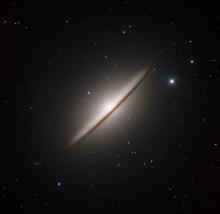Listen to today's episode of StarDate on the web the same day it airs in high-quality streaming audio without any extra ads or announcements. Choose a $8 one-month pass, or listen every day for a year for just $30.
You are here
Brighter Black Hole
The black hole at the center of the Milky Way Galaxy is an underachiever. It’s much fainter than similar black holes in other galaxies. But that hasn’t always been the case. Long ago, it might have shined a hundred million times brighter.
The black hole is called Sagittarius A-star. It’s in the constellation Sagittarius, which is in the southeast as night falls. Some of its stars form the outline of a teapot. Sagittarius A-star is immersed in the “steam” above the spout.
The black hole is four million times the mass of the Sun. It’s encircled by a faint disk of hot gas. Disks around similar black holes can shine a hundred million times brighter. Those black holes are pulling in a lot of gas and dust.
They’re heated to millions of degrees, so they shine brightly.
Sagittarius A-star is pulling in very little material, though, so it’s faint. It does occasionally flare up for a few hours — probably as it gobbles up an asteroid or other bit of debris. And a few hundred years ago, it shined up to a million times brighter than today.
Space telescopes have revealed what could have been even bigger outbursts in the past. There was one outburst from the galactic center about 15 million years ago. It could have been caused by the birth of many new stars. But it also could have been a flare-up of the black hole, perhaps as it devoured a star — a brilliant eruption for the Milky Way’s black hole.
More tomorrow.
Script by Damond Benningfield





